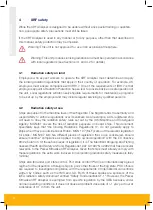
XRF Analyser Manual
2
1
About this manual
Important information is listed under the following symbols:
Caution
Note
2 Introduction
This manual covers the use and operation of the Parker Kittiwake XRF (X-Ray Fluorescence)
Analyser. The instrument is rugged, compact, stable and easy to operate. Besides being
able to accurately and rapidly measure the concentration of sulphur in marine fuels, it can
determine the concentration of wear metals in oil.
Sulphur in fuel will continue to be a hugely important issue in the marine shipping industry
for many years to come. Current regulations at time of writing, set out in Marpol Annex VI,
prevent the use of fuel with a sulphur concentration above 3.5% in much of the World’s
international waters (unless the vessel in question is fitted with a scrubber). From 1 January
2020 this limit will be reduced to 0.5%. The same regulations will continue to ensure
that only fuel with a sulphur concentration of less than 0.1% can be burnt in designated
Emission Control Areas (ECAs), such as the Baltic Sea.
The most cost effective way of meeting the 0.5% sulphur limit will be to be blend the
minimum amount of expensive, low sulphur, distillate with the maximum amount of cheap,
high sulphur, residual fuel oil. These fuels will surf a very fine line between economics
and legislative compliance. Going forwards, ships will need to be armed with the best
technology to ensure that they only buy and burn compliant fuel; anything else is likely to
lead to significant fines and a loss of reputation.
Condition monitoring of machinery lubricants is an established method of predicting and
avoiding impending machinery breakdown. Component wear and oil contamination can
be identified early and rectified before any serious damage occurs. Production can be
maintained, machinery life extended and the return on capital investment increased.
Summary of Contents for XRF
Page 1: ...XRF Analyser Instruction manual...
Page 2: ...XRF Analyser Manual...
Page 37: ...XRF Analyser Manual 35...





































